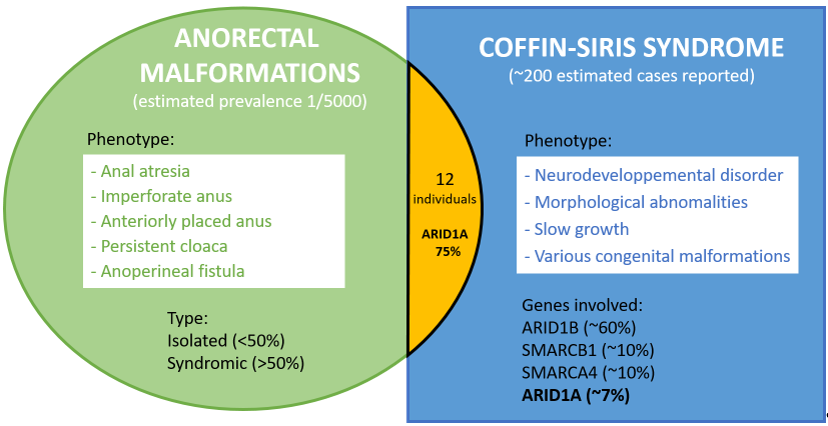Submitted:
13 November 2023
Posted:
14 November 2023
You are already at the latest version
Abstract

Keywords:
1. Introduction
2. Results
2.1. Case Report
2.2. Litterature review
3. Discussion
4. Conclusions
Author Contributions
Funding
Institutional Review Board Statement
Data Availability Statement
Conflicts of Interest
References
- Moore, S.W. Associations of Anorectal Malformations and Related Syndromes. Pediatr Surg Int 2013, 29, 665–676. [Google Scholar] [CrossRef] [PubMed]
- Wijers, C.H.W.; de Blaauw, I.; Marcelis, C.L.M.; Wijnen, R.M.H.; Brunner, H.; Midrio, P.; Gamba, P.; Clementi, M.; Jenetzky, E.; Zwink, N.; et al. Research Perspectives in the Etiology of Congenital Anorectal Malformations Using Data of the International Consortium on Anorectal Malformations: Evidence for Risk Factors across Different Populations. Pediatr Surg Int 2010, 26, 1093–1099. [Google Scholar] [CrossRef] [PubMed]
- Wood, R.J.; Levitt, M.A. Anorectal Malformations. Clin Colon Rectal Surg 2018, 31, 061–070. [Google Scholar] [CrossRef] [PubMed]
- Cuschieri, A. EUROCAT Working Group Descriptive Epidemiology of Isolated Anal Anomalies: A Survey of 4.6 Million Births in Europe. Am J Med Genet 2001, 103, 207–215. [Google Scholar] [CrossRef] [PubMed]
- Cuschieri, A. EUROCAT Working Group Anorectal Anomalies Associated with or as Part of Other Anomalies. Am J Med Genet 2002, 110, 122–130. [Google Scholar] [CrossRef] [PubMed]
- Gangopadhyay, A.N.; Pandey, V. Anorectal Malformations. J Indian Assoc Pediatr Surg 2015, 20, 10–15. [Google Scholar] [CrossRef] [PubMed]
- Fabian, J.; Dworschak, G.C.; Waffenschmidt, L.; Schierbaum, L.; Bendixen, C.; Heilmann-Heimbach, S.; Sivalingam, S.; Buness, A.; Schwarzer, N.; Boemers, T.M.; et al. Genome-Wide Identification of Disease-Causing Copy Number Variations in 450 Individuals with Anorectal Malformations. Eur J Hum Genet 2023, 31, 105–111. [Google Scholar] [CrossRef] [PubMed]
- Belanger Deloge, R.; Zhao, X.; Luna, P.N.; Shaw, C.A.; Rosenfeld, J.A.; Scott, D.A. High Molecular Diagnostic Yields and Novel Phenotypic Expansions Involving Syndromic Anorectal Malformations. Eur J Hum Genet 2023, 31, 296–303. [Google Scholar] [CrossRef] [PubMed]
- Dworschak, G.C.; van Rooij, I.A.L.M.; Reutter, H.M. The Role of De Novo Variants in Formation of Human Anorectal Malformations. Genes 2021, 12, 1298. [Google Scholar] [CrossRef] [PubMed]
- Exome Chip Association Study Excluded the Involvement of Rare Coding Variants with Large Effect Sizes in the Etiology of Anorectal Malformations | PLOS ONE Available online:. Available online: https://journals.plos.org/plosone/article?id=10.1371/journal.pone.0217477 (accessed on 27 October 2023).
- Kosho, T.; Okamoto, N. ; Coffin-Siris Syndrome International Collaborators Genotype-Phenotype Correlation of Coffin-Siris Syndrome Caused by Mutations in SMARCB1, SMARCA4, SMARCE1, and ARID1A. Am J Med Genet C Semin Med Genet 2014, 166C, 262–275. [Google Scholar] [CrossRef] [PubMed]
- Sekiguchi, F.; Tsurusaki, Y.; Okamoto, N.; Teik, K.W.; Mizuno, S.; Suzumura, H.; Isidor, B.; Ong, W.P.; Haniffa, M.; White, S.M.; et al. Genetic Abnormalities in a Large Cohort of Coffin–Siris Syndrome Patients. J Hum Genet 2019, 64, 1173–1186. [Google Scholar] [CrossRef] [PubMed]
- Vasko, A.; Drivas, T.G.; Schrier Vergano, S.A. Genotype-Phenotype Correlations in 208 Individuals with Coffin-Siris Syndrome. Genes 2021, 12, 937. [Google Scholar] [CrossRef] [PubMed]
- Slavotinek, A.; Lefebvre, M.; Brehin, A.-C.; Thauvin, C.; Patrier, S.; Sparks, T.N.; Norton, M.; Yu, J.; Huang, E. Prenatal Presentation of Multiple Anomalies Associated with Haploinsufficiency for ARID1A. Eur J Med Genet 2022, 65, 104407. [Google Scholar] [CrossRef] [PubMed]
- van der Sluijs, P.J.; Joosten, M.; Alby, C.; Attié-Bitach, T.; Gilmore, K.; Dubourg, C.; Fradin, M.; Wang, T.; Kurtz-Nelson, E.C.; Ahlers, K.P.; et al. Discovering a New Part of the Phenotypic Spectrum of Coffin-Siris Syndrome in a Fetal Cohort. Genetics in Medicine 2022, 24, 1753–1760. [Google Scholar] [CrossRef] [PubMed]
- Halgren, C.; Kjaergaard, S.; Bak, M.; Hansen, C.; El-Schich, Z.; Anderson, C.; Henriksen, K.; Hjalgrim, H.; Kirchhoff, M.; Bijlsma, E.; et al. Corpus Callosum Abnormalities, Intellectual Disability, Speech Impairment, and Autism in Patients with Haploinsufficiency of ARID1B. Clinical Genetics 2012, 82, 248–255. [Google Scholar] [CrossRef] [PubMed]
| Gene | Variant | ARM Type | Reference |
|---|---|---|---|
| ARID1A | NM_006015:c.6134_6138del p.(K2045Rfs*52) | IA, APA | [8] |
| NM_006015:c.4886dup p.(V1630Cfs*18) | APA | [14] | |
| arr[hg19] 1p36.11(26,797,508_27,052,080)×1 | IA | [14] | |
| n.a* | AA | [15] | |
| n.a* | AA | [15] | |
| n.a* | AA | [15] | |
| n.a* | AA | [15] | |
| n.a* | APA | [15] | |
| n.a* | APA | [15] | |
| ARID1B | arr[hg19] 6q25.3(157,079,676-157,806,675)x1 | AA | [16] |
| NM_017519.3:c.5227_5228insCA p.(L1743Pfs*12) | APA, AF | This study | |
| SMARCA4 | NM_001128849:c.2656A>G p.(M886V) | Not specified | [8] |
Disclaimer/Publisher’s Note: The statements, opinions and data contained in all publications are solely those of the individual author(s) and contributor(s) and not of MDPI and/or the editor(s). MDPI and/or the editor(s) disclaim responsibility for any injury to people or property resulting from any ideas, methods, instructions or products referred to in the content. |
© 2024 by the authors. Licensee MDPI, Basel, Switzerland. This article is an open access article distributed under the terms and conditions of the Creative Commons Attribution (CC BY) license (https://creativecommons.org/licenses/by/4.0/).





